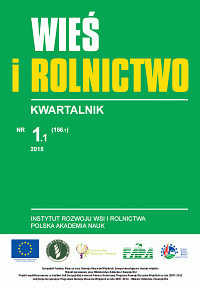Społeczne i ekonomiczne aspekty funkcjonowania drobnych gospodarstw rolnych w Polsce
Social and economic aspects of the functioning of small agricultural holdings in Poland
Author(s): Monika Szafrańska, Janusz ŻmijaSubject(s): Economy
Published by: Instytut Rozwoju Wsi i Rolnictwa Polskiej Akademii Nauk
Keywords: small agricultural holding; socio-economic functions of agricultural holdings; drobne gospodarstwo rolne; funkcje ekonomiczno-społeczne gospodarstw rolnych
Summary/Abstract: A definition of a small agricultural holdings is a farm on which the agricultural land area does not exceed 5 ha. In Poland, in 2012, 758 924 such small agricultural holdings were in existence and account for 52.1% of all agricultural holdings. Productivity of these farms is low due to their small land area, low profitability and weak connections with markets. Apart from the productive function of the small farm, attention should also be given to their role in Polish rural communities in protecting against poverty and exclusion, social care for the youngest and the oldest inhabitants, the creation of human capital, their cultural capital, maintaining the rural landscape, as well as providing food produced often with minimum inputs and often of higher quality to the market. The aim of the article is to present and characterise selected social functions, provided by a family owned agricultural holding in Poland. The article includes references from combined serial scientific publications and other papers, as well as data from National Statistics (information included in the 2013 Agricultural Statistics Yearbook). Dynamic and vertical methods were used for statistical data analysis. The obtained research results have been presented in a descriptive and tabular format. Drobne gospodarstwo rolne to gospodarstwo, w którym powierzchnia użytków rolnych nie przekracza 5 ha. W 2012 roku funkcjonowały w Polsce prawie 758 924 drobne gospodarstwa rolne, stanowiąc 52,1% wszystkich gospodarstw rolnych. Ze względu na ich mały obszar, niską dochodowość i słabe powiązania z rynkiem drobne gospodarstwa rolne w Polsce w niewielkim stopniu spełniają funkcje produkcyjne. Główne korzyści funkcjonowania tych jednostek związane są z pełnieniem rozlicznych funkcji o charakterze społecznym i środowiskowym, jak: ochrona przed ubóstwem i wykluczeniem, opieka nad najmłodszymi i najstarszymi mieszkańcami wsi, tworzenie kapitału społecznego, kapitału kulturowego, kształtowanie krajobrazu wiejskiego, dostarczanie na rynek żywności wytworzonej w sposób bardziej naturalny i wyższej jakości. Celem niniejszego artykułu jest przedstawienie i ocena wybranych funkcji społeczno-ekonomicznych, jakie pełnią drobne gospodarstwa rolne w Polsce. W opracowaniu wykorzystano publikacje naukowe zwarte i ciągłe oraz dane statystyki masowej (informacje zamieszczone w [Roczniku Statystycznym Rolnictwa 2014]). Do analizy danych statystycznych wykorzystano analizę porównawczą (dynamiki) oraz analizę struktury. Uzyskane wyniki badań zostały przedstawione w formie opisowej i tabelarycznej.
Journal: Wieś i Rolnictwo
- Issue Year: 166/2015
- Issue No: 1(1)
- Page Range: 155-165
- Page Count: 11
- Language: Polish

